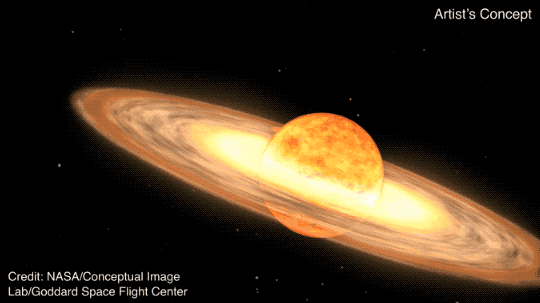The world is about to see a stellar event that was likely first recorded in 1217; a nova explosion of T Coronae Borealis (T CrB), also known as the Blaze star.
The star – actually a binary star system comprising a white dwarf and a red giant – is for the most part not visible from Earth without the aid of a telescope. Lying 3,000 light-years away from the Earth, the white dwarf’s gravity slowly pulls away material from the red giant, eventually producing a once-in-a-lifetime (or twice if you are incredibly lucky) event.
“The stars are close enough that as the red giant becomes unstable from its increasing temperature and pressure and begins ejecting its outer layers, the white dwarf collects that matter onto its surface,” NASA explains. “The shallow dense atmosphere of the white dwarf eventually heats enough to cause a runaway thermonuclear reaction – which produces the nova we see from Earth.”

Thar she blows!
Credit: NASA’s Goddard Space Flight Center
This happens around every 80 years or so. We know this because of observations in 1866 and 1946, when the star system brightened several thousand-fold and became visible to the naked eye. The star appeared almost as brightly in the sky as our (sometimes) north star Polaris.
These may not have been the first times that the nova has been observed. In December 1787, Reverend Francis Wollaston observed and documented a star in T Coronae Borealis’s position, likely to be the blaze star once again going nova.
We may also have a far older description of the star, going all the way back to 13th-century Bavaria.
“The 1217 event has an eyewitness report written by Abbott Burchard of Upsberg as a fast-rising stellar point-source (‘stella’) in Corona Borealis that ‘shone with great light,’ lasted for ‘many days,’ and was ascribed as being a ‘wonderful sign’,” Bradley Schaefer, Professor Emeritus at Louisiana State University’s Department of Physics & Astronomy wrote in a 2023 paper published in the Journal for the History of Astronomy.
“This event cannot be a report of a comet, because Burchard used the term for a star (‘stella’) and not for a comet, and because Burchard had the omen being very positive, with such being impossible for comets that are universally the worst of omens. The reported event is just as expected for a prior eruption of T CrB, and all other possibilities are strongly rejected, so the case for the 1217 eruption of T CrB is strong.”
Prior to previous explosions, the star underwent a rise in brightness, followed by a pre-eruption dip.
“The T CrB Pre-eruption Dip has already started in March/April of this year,” the American Association of Variable Star Observers (AAVSO) explains. “If the Dip in 2023 is similar in timing to that in 1945, then the primary eruption should occur roughly 1.1±0.3 years later, or in 2024.4±0.3.”
Based on the previous dips and eruptions, astronomers expect the next nova to happen between now and September. Keep an eye on the constellation Corona Borealis over the coming months (don’t worry, you are unlikely to miss the news when it happens) and you will witness this once-in-a-lifetime event, just as they likely did all the way back in 1217. If not, you could always catch Comet C/2023 A3 as it becomes visible in the coming months.
Source Link: We're About To Witness A Stellar Event Potentially First Recorded In A Medieval Manuscript